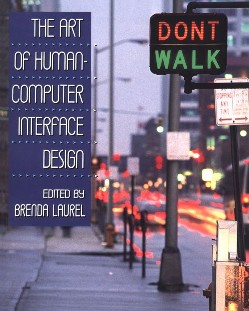 Zusammenfassungen
Zusammenfassungen
 A treasury of ideas and opinions from leading thinkers in the computer industry, 'Art of Human-Computer Interface Design' delves into the strategies, reasoning, and future direction of human-computer interaction and the overall relationship between computers and people.
A treasury of ideas and opinions from leading thinkers in the computer industry, 'Art of Human-Computer Interface Design' delves into the strategies, reasoning, and future direction of human-computer interaction and the overall relationship between computers and people. This book started as an interior project at Apple, then grew into a more diversified attempt to survey the varied philosophies, design methods, and technological approaches that have recently evolved. It draws on essays from interface design specialists, as well as works by those involved with drama and narrative, industrial design, animation, and cognitive and interpersonal psychology.
 Kapitel
Kapitel 
- User Interface - A personal view (Alan Kay) (1990)


 Dieses Buch erwähnt ...
Dieses Buch erwähnt ...
 Dieses Buch erwähnt vermutlich nicht ...
Dieses Buch erwähnt vermutlich nicht ... 
 Nicht erwähnte Begriffe | Criterion of Sense, Criterion of Time, Formal-operatives Denken, Horizontal Criterion, Konkrete Operationen, Präoperationales Stadium, Schule, Sensumotorisches Stadium, Vertical Criterion |
 Tagcloud
Tagcloud
 Vorträge von Beat mit Bezug
Vorträge von Beat mit Bezug
 Zitationsgraph
Zitationsgraph
 Zitationsgraph (Beta-Test mit vis.js)
Zitationsgraph (Beta-Test mit vis.js)
 Zeitleiste
Zeitleiste
 14 Erwähnungen
14 Erwähnungen 
- Macintosh human interface guidelines (1992)


- MOOSE Crossing - Creating a Learning Culture. (Amy Bruckman) (1994)


- Grundlagen hypermedialer Lernsysteme - Theorie - Didaktik - Design (Rolf Schulmeister) (1996)



- Bringing Design to Software (Terry Winograd) (1996)
- Die Konsequenzen von Informationsassistenten - Was bedeutet informationelle Autonomie oder wie kann Vertrauen in elektronische Dienste in offenen Informationsmärkten gesichert werden? (Rainer Kuhlen) (1999)



- The Humane Interface - New Directions for Designing Interactive Systems (Jef Raskin) (2000)


- Pause & Effect (Mark Stephen Meadows) (2002)
- Tracing the Dynabook - A Study of Technocultural Transformations (John W. Maxwell) (2006)


- Informatik in Bildung und Beruf - INFOS 2011 - 14. GI-Fachtagung Informatik und Schule (Marco Thomas) (2011)


- Informatik begreifen - Zur Nutzung von Veranschaulichungen im Informatikunterricht (Manuela Kalbitz, Hendrik Voss, Carsten Schulte) (2011)


- Informatik begreifen - Zur Nutzung von Veranschaulichungen im Informatikunterricht (Manuela Kalbitz, Hendrik Voss, Carsten Schulte) (2011)
- Die Analogie - Das Herz des Denkens (Douglas Hofstadter, Emmanuel Sander) (2013)

- Coding Literacy - How Computer Programming Is Changing Writing (Annette Vee) (2017)

- Kritik der Digitalität (Jan Distelmeyer) (2021)


 Co-zitierte Bücher
Co-zitierte Bücher

Understanding Computers and Cognition
A New Foundation for Design
(Terry Winograd, Fernando Flores) (1987)



Computer Lib
(Ted Nelson)

Oralität und Literalität
(Walter Ong) Volltext dieses Dokuments
Volltext dieses Dokuments
 | The Art of Human-Computer Interface Design: Gesamtes Buch als Volltext ( : :  , 26173 kByte) , 26173 kByte) |
 | User Interface: Artikel als Volltext ( : :  , 640 kByte) , 640 kByte) |
 Standorte
Standorte 
 Bibliographisches
Bibliographisches 
| Titel | Format | Bez. | Aufl. | Jahr | ISBN | ||||||
| The Art of Human-Computer Interface Design | D | - | - | 1 | 1990 | 0201517973 |  |
 |
 |
 Beat und dieses Buch
Beat und dieses Buch
Beat war Co-Leiter des ICT-Kompetenzzentrums TOP während er dieses Buch ins Biblionetz aufgenommen hat. Die bisher letzte Bearbeitung erfolgte während seiner Zeit am Institut für Medien und Schule. Beat besitzt kein physisches, aber ein digitales Exemplar. (das er aber aus Urheberrechtsgründen nicht einfach weitergeben darf). Beat hat dieses Buch auch schon in Vorträgen erwähnt.









 Computer
Computer Denken
Denken enaktive Repräsentation
enaktive Repräsentation Fernsehen
Fernsehen ikonische Repräsentation
ikonische Repräsentation Lernen
Lernen LOGO (Programmiersprache)
LOGO (Programmiersprache) Repräsentationstrias / EIS-Prinzip
Repräsentationstrias / EIS-Prinzip symbolische Repräsentation
symbolische Repräsentation User Interface (Benutzerschnittstelle)
User Interface (Benutzerschnittstelle) Werkzeuge
Werkzeuge








 Biblionetz-History
Biblionetz-History